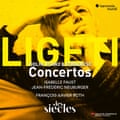The remarkable stylistic evolution of György Ligeti during the monotonous 1970s and early 1980s is often hailed as one of the most extraordinary and surprising transformations in a composer’s career.This shift can be likened to Stravinsky’s transition into neoclassicism in the 1920s, and also his embrace of serialism in the 1950s. The unique musical language that Ligeti crafted for himself,which redefined tonality through innovative relationships and incorporated elements from various non-western musical traditions,was first revealed in his Horn Trio from 1982. However,it was truly showcased with full force in his subsequent concertos for piano (1988) and violin (1993).

Both concertos are extraordinary compositions that feel entirely contemporary yet unmistakably belong to the concerto tradition. It comes as no surprise that Ligeti’s violin concerto has been embraced by numerous soloists; notably, Isabelle Faust has expressed her desire to contribute her interpretation to her discography with Harmonia Mundi. Her performance is celebrated for its insightfulness and technical precision but may come across as slightly detached emotionally; it is paired with a similarly executed yet somewhat more mechanical rendition of the piano concerto featuring Jean-Frédéric Neuburger as soloist.
Would you like to enable content provided by a third party?
This article includes content hosted on embed.tune.apple.com we ask for your permission before anything else loads as this provider may also use cookies or other technologies To view this content,click ‘Enable and continue’.
Listen on Apple Music above or via Spotify.